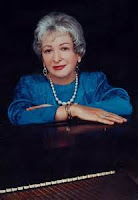 |
| Beethoven |
Here's a brain teaser for you. Look at the example below. I think the editor devised the fingering while riding the bus to his regular day job. Try to find a more agreeable fingering for these measures. We want fluency and lyricism, not to mention ease of execution. The answer will appear in these pages in a few days. Your reward will be the satisfaction of knowing that you can make virtually any passage feel easy. Your friends will marvel at the brilliant glow of your new aura.
 |
| Beethoven Sonata Op. 57 |

























